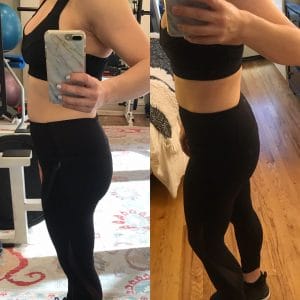Two weeks before my wedding I did what many brides have done before me and many will do after: I stopped eating carbohydrates. Now when I say carbs, I really mean grains and starchy foods. Broccoli was okay. Sushi rice? No. Sweet potatoes? Sadly, no. Eliminating breads, starches, and baked goods in addition to cutting out alcohol, processed sugar, and dairy—on the advice of my trainer—quickly whittled my waist, chiseled my arms, and sharpened my jawline.

Courtesy Getty Images
I decided to ghost all the carbs in my life after my final dress fitting at the Saks Fifth Avenue bridal salon. The lace corset top of my Reem Acra gown hugged my chest, causing my back and arms to spill-out. Concerned I wouldn’t feel confident in photos, I made an emergency call to celebrity trainer and author David Kirsch. He not only works with celebrities like Jennifer Lopez and Kate Upton (who often grace his Instagram page), but he’s also the Director and Curator of Fitness & Wellness Programming at the Core Club. After training with him three to four times a week and following his diet advice, my body was completely transformed.
https://www.instagram.com/p/BU2gMp6hzm4/?taken-by=laurenlevinson
It’s been a year since I got married, and my goals today are quite different: Mainly, I don’t want to feel like I’m on a permanent bridal diet. I’m a 5 foot one-and-a-half inches tall, 33-year-old woman with an active Equinox membership who eats a mostly organic, plant-based diet and is educated on macros, Weight Watchers points, and Whole30. Basically, I know what I should be eating and how much of it. I was seeking an eating plan that would not eliminate entire food groups, allow for the occasional Levain cookie, and not make me count anything (calories, points, or steps).
I reached out to Kirsch again last month and asked him: “David, how do I live if I am not willing to consume steamed kale and fish for every meal?” For the record, my goal is not about weight loss, but rather achieving an overall slim feeling. I want to debloat while still eating pasta and drinking wine. Do I have to be deprived to feel svelte? What’s the secret?
I want to debloat while still eating pasta and drinking wine. Do I have to be deprived to feel svelte? What’s the secret?
Kirsch’s answer: it’s as simple as portion control and timing. He put me on a 12-day lifestyle plan: I’d workout five times a week (yoga counts!), add in strength training, and stop eating carbs after 2:30 p.m.. The time 2:30 p.m. was chosen as a guesstimate rather than an exact science. We wanted to give my body a chance to burn off any of the carbs I consumed earlier in the day to help me debloat overnight.
“Eating carbs in the morning and throughout the middle of the day helps you fuel properly for the entire day,” says Kirsch. “Because carbs retain water in your body, you start looking fuller. Cutting your carb intake off at a certain point, such as 2:30, gives your body a chance to absorb and drain all of that excess water. It also gives you time to burn them off throughout the rest of the day.”
THE SCIENCE BEHIND CUTTING CARBS
When I consulted with two doctors about Kirsch’s theory, their support was mixed. Dr. Kurt Waples, a functional medicine doctor, doesn’t buy into 2:30 being a magic hour. “Because carbohydrates can spike blood sugar, we want to make sure we aren’t spiking and crashing during the earlier part of the day when we need to focus and drive,” he explains. He’s part of the camp that believes carbs can make you groggy—a feeling you don’t want before giving a work presentation or getting on a Peloton bike.
On that note, carbohydrates may help us sleep better. “Carbs have been shown to increase serotonin uptake,” Dr. Waples says. “Serotonin is a neurotransmitter that is most optimal to have increased levels of at night as it promotes healthy sleep.” So eating carbs at night could theoretically help you sleep more soundly.
He goes on to explain the relationship between serotonin and sleep—and what that means for how your jeans fit. “Serotonin function is important for sleep in that serotonin is the direct precursor to melatonin, your sleep hormone,” Dr. Waples notes. “Eating carbs at night can boost serotonin, which will convert into melatonin and help support a healthy night sleep. We know from studies on lack of sleep that one bad night can lead to eating hundreds of calories more the next day, which would lead to increase cortisol, fat gain, and ultimately an unhealthy state.”
Dr. Keith Berkowitz, an MD who specializes in diet and health, has a different view of how carbs impact sleep. “Your energy needs and demands are much lower at night than during the day when you’re more active,” he says. “So if you have a high-carb meal at 8 p.m., the excess calories will be stored. When stored, it can lead to weight gain. Plus, if you are having more carbs and spiking more insulin, it is going to affect sleep negatively.”
We know from studies on lack of sleep that one bad night can lead to eating hundreds of calories more the next day, which would lead to increase cortisol, fat gain, and ultimately an unhealthy state.
The same ideas can be applied to bloating. “Most people have their bowel movement in the morning,” Dr. Berkowitz explains. “As they consume food during the day and evening, it’s more of a challenge. The more you’re trying to push in, the more problematic it’s going to be. That’s why people tend to be more bloated at night.” That said, everyone is different when it comes to how carbs affect their bodies and sleep, so talk to your doctor before you start setting a no-carb timer for the afternoon.
HOW EXERCISE AFFECTS CARBS
What both Dr. Waples and Dr. Berkowitz agree on is to pay attention to the timing of carbs before and after exercise. “We treat athletes in the office who perform better with a jolt of liquid carbs before they workout or compete,” notes Dr. Waples. “Others get slow and bogged down by this and do better with sips of carbs intra workout. Still, there is another group who do better with carbs post-workout to help replenish glycogen stores and to recover.”
Dr. Berkowitz is a fan of eating carbs before you workout—even if it’s at night (but just a little, like a Wasa Cracker). “Carbohydrates are better served pre-workout rather than post-workout,” he notes. “Because your energy needs during the workout are higher, you want to burn that.”
Since I worked out with Kirsch in the mornings at around 8:30 a.m., it made sense that I would consume most of my carbs for breakfast and lunch.

Courtesy Getty Images
THE DIET DETAILS
Not all carbs are created equal, and what you combine them with absolutely matters. “We really should use foods to support blood sugar balance, proper interaction with cortisol, and healthy serotonin regulation, which is important for sleep,” Dr. Waples explains. “This applies to carbs, which have the ability to spike blood sugar if not combined with protein and fiber.”
For my experiment, I focused on mainly eating gluten-free carbs and whole grains, which are easier to digest than complex carbs. “Foods like steel cut oats, lentils, brown rice and quinoa are best to consume before 2:30 p.m.,” advises Kirsch. “These carbs are better for you than breads or pasta because they are rich in the vitamins and minerals you need to gain lean muscle.”
Kirsch also encouraged me to cut my portions down. For example, I’m crazy about sweet potatoes, which are a staple in any healthy diet and high in vitamin A, vitamin C, and fiber. But they’re sugary, coming in at approximately 24-27 grams of carbs per potato. Kirsch encouraged me to bake one sweet potato at the beginning of the week and eat it in fourths. Gone were the days of downing one whole potato in a single sitting like a normal person. On the new plan, lunch consisted of throwing homemade grilled chicken, one fourth of a sweet potato, and tons of veggies together in a salad.
“Depending on your weight and lifestyle, the amount of carbs you should eat can change,” Kirsch notes. “There is no set amount of carbs a person should have throughout the day. If you are a male athlete training for an upcoming game or marathon, your carb intake is going to be different than a young woman who works at a corporate job all day.”
THE RESULTS

Courtesy of Lauren Levinson
Diets are not one-size-fits-all, but for me, this plan worked to flatten my stomach (see the before and after photos above). While I did not weigh myself, since my goal was to debloat rather than shed pounds, my jeans fit dramatically better and my waist felt more contoured.
“What I’ve noticed with weight loss is the more you move your bigger meals to earlier in the day, the more successful people tend to be,” Dr. Berkowitz says. And for me, that theory proved to be true.
I also was less anxious about eating in general. Knowing I could have a slice of whole wheat margherita pizza for lunch (and I certainly did during the 12 days) kept me from feeling deprived. Nothing was off limits, so I was less likely to get cravings and then overeat. When it came to continuing the plan, I adopted the 80/20 rule. That leaves the chance for me to go to Gramercy Tavern with my husband for a Saturday night dinner and go to town on the cheese-infused homemade bread.
What I’ve noticed with weight loss is the more you move your bigger meals to earlier in the day, the more successful people tend to be.
SAMPLE MEAL PLAN
Breakfast:
• Black coffee
• One hard-boiled egg
• One piece of Trader Joe’s Gluten-Free Crispbread with natural peanut butter
• Or gluten-free oatmeal with flaxseed, chopped almonds (Kirsch says go for the slivers since you feel like you’re getting more crunch but actually eating less), and blueberries
Workout:
Strength circuit training with Kirsch (his workout videos can be streamed), a hip-hop dance class, a barre class, or yoga
Lunch:
• Salad with kale, radishes, carrots, pumpkin seeds, grilled chicken, a scoop of quinoa or one fourth of a sweet potato, and dressing (EVOO and balsamic vinegar)
• Two pieces of organic dark chocolate
Snack:
• Sliced crunchy vegetables, such as cucumber, carrots, and peppers with Abraham’s Flaxseed Hummus
• Handful of raw almonds
Dinner:
• Salmon baked in lemon and olive oil
• Roasted broccoli in garlic and olive oil
• Roasted butternut squash with olive oil and a dollop of Vermont maple syrup
• Two glasses of white wine
From: Harper’s BAZAAR US



